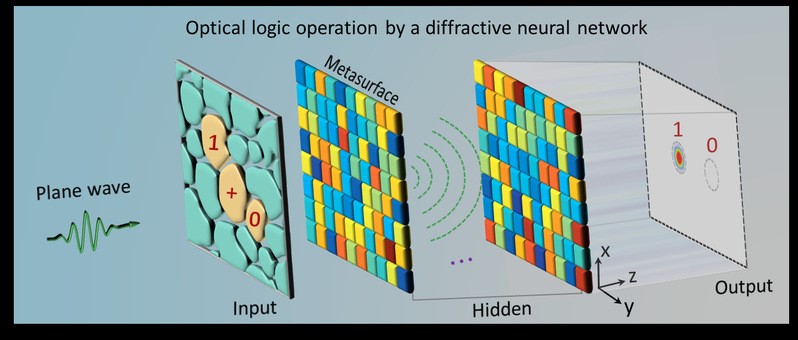Qian Chao, Ph.D. student (Supervisor: Prof. CHEN Hongsheng), proposed and realized the optical logic calculation based on diffractive neural network. The related paper Performing Optical Logic Operations by a Diffractive Neural Network was published online on April 13, 2020 in Light: Science & Applications, a top optical Journal of Nature (latest impact factor 14.0).
Optical computing is a new computing technology which uses photons as the carrier. It uses the inherent characteristics of light to deal with complex computing tasks. Compared with the traditional electronic computing, it has the advantages of high speed, low loss, high computing power, and small information distortion. Although it is expected to be a promising technology in the scenes with high real-time requirements such as unmanned driving and image detection, it still has the limitation of the highly accurate control demand of optical logic computing.
In this paper, from the perspective of machine learning, the optical logic calculation is equivalent to the classification task. QIAN has come up with a design method of optical logic unit based on diffractive neural network is proposed, and the feasibility and completeness of this method are proved theoretically. As shown, this design method does not need complex optical control system, but uses simple plane wave as input, and realizes different logic calculation functions by selectively activating the sub areas of input layer. The design of the input layer is very simple, flexible and universal. The mode of allowing / prohibiting plane wave transmission can be adopted or changed into a user-defined mode according to the actual application scenario requirements.

The researchers obtained the super participation weight coefficient of diffractive neural network through learning and training, and the output accuracy reached 100%. In the microwave experiment, the researchers used the high-efficient medium super structure surface as the hidden layer of neural network, and successfully verified the feasibility of the scheme. “It can integrate seven basic logic functions or build a cascaded network to form complex computing or storage functions, and it is suitable for terahertz, optical frequency and other physical waves,” said QIAN.
This theory and experiment realizes a universal design method of multi-functional optical logic operation, which has a wide application prospect in the fields of encrypted wireless communication and scene enhancement. Moreover, the design method can be extended to adaptive optical imaging, fast target tracking, pattern recognition and so on.
Coauthors include LIN Xiaobin, Ph.D. student of ISEE, SUN Yang, undergraduates of ISEE, Prof. LI Erping, Dr. LIN Xiao and Prof. ZHANG Bole from Nanyang Institute of technology, Singapore and JIAN Xu, Ph.D. student from Caltech. The corresponding authors are Dr. LIN Xiao, Prof. ZHANG Bole and Prof. CHEN Hongsheng. The work is supported by the National Natural Science Foundation of China.
(From College of Information Science & Electronic Engineering)

